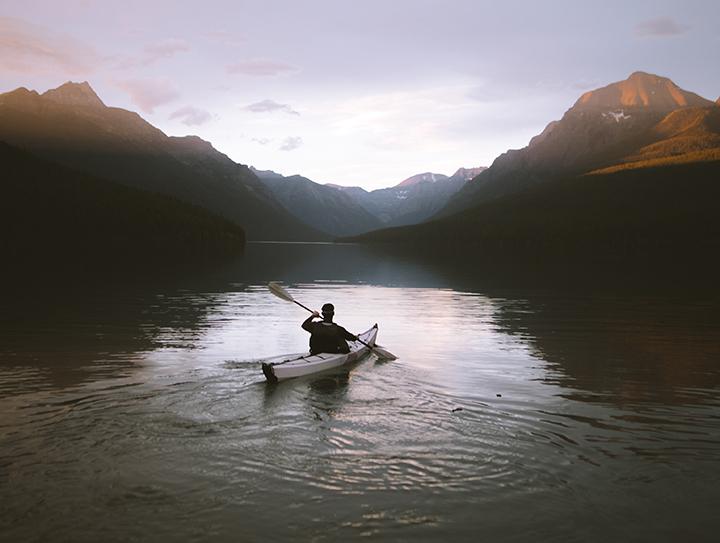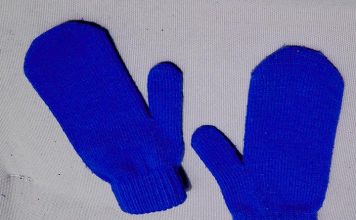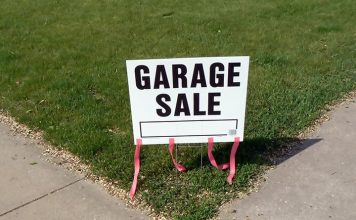| Issue #46 • July/August, 1997 |
A canoe and kayak livery business is inexpensive to start and it’s easy to operate. The business fits in well with country living since it can be as demanding as you wish it to be. For those of us in the northern climes, it is a seasonal business, so gives you plenty of time to do other things during the off season. The business can be part-time, or it can be full time during the peak season of operation, depending upon your desires and needs.
The canoe livery business is also a great way to meet interesting folks. I have met visitors from foreign lands, and folks from the other side of the country. It’s a great time to meet people, because most of your customers are there for recreational reasons, which means they are relaxed, and they are ready to learn new things. Another interesting facet of the business, is that most of the folks whom you meet are interested and active in the outdoors. Every canoe livery operator that I know has a deep and abiding respect for the environment. Many livery operators sponsor river clean ups and perform many other environmentally beneficial activities.

It doesn’t take a whole lot to start the business, but there are a few things that you do need to be successful. The first requirement for the business is a close proximity to water. Most liveries have property adjacent to a body of water, though this is not an absolute requirement. In fact, my own business is not located directly on the water. The type of water that your business is located on is important. I would not advise anyone starting out fresh to rent canoes on whitewater. A stream or river with moving water is typically a good rental location, but one should also consider larger bodies of water like lakes that are located in popular tourist areas. A typical livery business will be on a small river with just enough current that the canoes will move along without having to paddle a lot.
The average canoe trip should take about 3-6 hours at a leisurely pace. The boats and customers are then picked up at the end of the trip, and brought back to their starting point. The take out, and put-in locations can be owned by you, but there are other alternatives. Sometimes you can start and end the canoe trip on public lands, owned by a county, state, or federal government.
The requirements for operating on public lands vary. Some governmental agencies require permits, insurance, and they charge a concession fee. Other governmental agencies just accept this as part of normal land usage and they don’t have any requirements or charges. It’s best to make some inquiries with the appropriate government agencies while your business is still in the planning stages. Another alternative to owning waterfront property is an easement. You can obtain an easement from private landowners in order to get the required access to bodies of water. A private landowner will usually grant you an easement for a nominal fee. I would strongly advise you to contact an attorney in any case where you do not actually own the land that you’ll be using.
Canoes and kayaks
The other main ingredient for a successful canoe livery business is a quantity of canoes and/or kayaks. Obtaining canoes and kayaks for your business can be an interesting experience. One way is to simply advertise for used canoes and kayaks in your local newspaper or pennysaver. Using this method means that you will probably end up with a hodgepodge of boats in your rental fleet. Your customer simply wants a boat that is safe and one that will get him or her where they want to go, so in many cases it doesn’t matter what kind of canoe you are renting, as long as it’s safe. This is probably the least expensive way to get into the business. Examine your potential purchase carefully. Will the boat be easy to repair if it becomes damaged? Does it currently require repairs? Is it safe?
I try to make sure that all the boats I have in my fleet are inherently stable. Customers are usually not too happy if they go for an unscheduled swim, or if it takes considerable effort to keep the boat upright. Remember you are looking at the watercraft from a livery owners perspective.
The other way to obtain watercraft is to purchase them from manufacturers. Most manufacturers have a purchase program for liveries. These programs usually require you to purchase a certain number of boats, which can add up very quickly. Think carefully before you purchase a lot of boats.
How many boats do you need to start your business? For a part-time business you can easily get by with 3-4 boats, in fact during my first year of operation I started with just 4 boats. I’m currently renting around 40 boats, and I know livery operators who have over 1200 boats to rent. You can grow as necessary. One of the benefits of purchasing a quantity of boats from a manufacturer is that they will probably have the same style, giving your fleet a professional appearance.
What type of canoe should you buy, aluminum, plastic, or fiberglass? I actually own canoes manufactured out of all three types of materials. The aluminum and plastic canoes will last the longest. Yes, canoes do wear out. More and more of the liveries are switching to plastic canoes which are actually constructed out of either polyethylene or royalex. Both materials are very durable. Plastic canoes tends to be quieter in the water than aluminum canoes, and the material doesn’t transmit differences in temperature like aluminum. Another important factor regarding plastic boats, is that they don’t tend to hang up on rocks like aluminum boats, this is important if your business will be operating on a rocky stream or river. Choose boats that will take the punishment of frequent use. Look at the seats to ensure that they are well constructed, and that they are also comfortable. At the end of the article there is a list of some companies that offer livery purchase programs. I would strongly suggest that you shop around, as boat prices do vary widely.
When starting small you don’t even need a canoe trailer to haul boats. During the first few years of our operation, we used a pickup truck to haul both boats and customers. Later as your business grows you can make or purchase trailers for moving canoes.
The daily operation of a canoe business is relatively easy. Let’s look at a typical scenario…A customer stops in to rent a boat. You should first gauge his experience level. Will the trip be too strenuous for him or her? If so, make an alternative recommendation, such as a shorter trip. Next give them a briefing about how to safely paddle, and what to expect on their trip. At this point we distribute their personal flotation devicesor life jackets as they were once called. In the interest of safety we require all renters to wear their personal flotation devices. It makes me sleep better at night.
We also distribute paddles at this time and give the folks a chance to try paddling techniques on land before they get into that moving boat. Customers then complete two important documents, a rental agreement and a waiver of liability. The rental agreement simply outlines what the renter is renting, how much they are paying for the rental equipment, and it also outlines what happens if the renter brings back the equipment in a damaged condition. The liability waiver is signed by all members of the rental party. This hopefully provides you with some protection in the event that something unfortunate occurs. These forms can be drawn up by your attorney or your insurance company.
Liability insurance
This is a good time to discuss on-water liability insurance. Many canoe liveries do not carry any liability insurance for on-water activities. This is a decision that you need to make. There are many factors to consider such as the type of water you are renting on and how much you have to lose if a lawsuit does occur. It is best, again, to consult with your attorney and your insurance agent. Unfortunately, many of the local agents are not knowledgeable about the paddlesports industry, so I have provided a list at the end of the article of companies that I do know take an active role in the industry. I do not endorse any of them, they are simply there for reference purposes.
Going back to our original rental scenario…our renter has completed the necessary paperwork. At this point we collect the rental fee and security deposit. Now the customer is ready to go. I usually try to provide a map of the trip, just as an additional way of ensuring for the comfort of my guest. The renter is provided with a boat, and arrangements are made to pick the party up within a specific time period. Since my business is not on the water, we provide our customers with foam blocks and ropes that permit them to transport the boats wherever they desire. Please note that we do obtain a security deposit and drivers license information prior to letting them drive off. Actual damage to our equipment has been a pretty rare occurrence.
Later in the day we go to the pick-up area to retrieve the boat and to transport the customers. In some cases the customers bring the boats back themselves using the foam blocks and rope we have provided. We make sure that the customers have had a good time, because if they have, then more than likely they will be back. After examining the condition of the equipment we refund their security deposit. The equipment is then cleaned and prepared for the next rental customer.
The going rate for canoe rentals varies across the country from around $15 to $55 per day. The differences can be attributed to the material that the boat is constructed of. We rent canoes made of cedar strip and carbon fiber. These boats can weigh from 30 pounds up, and they can cost several thousand dollars. It takes quite a while to recoup your investment when the boat is expensive. Aluminum and plastic boats cost much less and they can actually last decades depending upon the use. Many livery operators sell off a portion of their fleet at the end of the season and keep rotating their rental boats by buying a quantity of new boats at the beginning of the season. These culled watercraft are quite serviceable and they can provide you with another means of obtaining boats. Depending upon the size of your operation, you can reasonably expect to make from $2000 to $40,000 depending upon your location and the number of boats that you rent.
Advertising
Advertising your canoe livery business can be a challenge, just like any business. We try to advertise in recreational oriented media, such as outdoor magazines, at sports shows, and in tourism booths. Don’t overlook your local chamber of commerce. For my business, one of the best non-traditional marketing means has been the internet, and we have been quite successful teaming up with local motels in promoting mini vacation packages. If you’re located near a major population center it’s best to advertise there. I live in a very remote area, and my average customer is located from 200-500 miles away, and we have had a number of international visitors too.
You will need to try different media to see which works best for you. I know some livery operators who swear by newspaper and radio ads, but neither has worked well in my area. From personal experience and from conversing with other livery operators, national magazine advertising, though expensive, is very effective. Again, it depends upon the market you are trying to reach.
A good resource for anyone starting a canoe livery business is the Professional Paddlesports Association, which is dedicated to supporting paddlesports businesses. They can help you organize your business and make it more professional. Another good resource is the American Canoe Association which can also help you become a better trained paddler if you aren’t already active in paddlesports. Membership in both organizations is money well spent. Their addresses are listed at the end of this article.
If you are located near a body of water, and you enjoy meeting new folks and you like the outdoors think about starting your own rewarding canoe livery business. I can honestly say that I don’t have any regrets after working in the outdoor business over ten years…try it, I think you’ll like it!
| Paddlesports Organizations | |
|---|---|
| Professional Paddlesports Assn. P.O. Box 248Butler, KY. 41006 606-472-2205 |
American Canoe Association 7432 Alban Station Blvd. B-226 Springfield, VA 22150-2311 703-451-0141 |
| Canoe & Kayak Manufacturers | ||
|---|---|---|
| Old Town Canoe Company 58 Middle Street Old Town, ME 04468 207-827-5514 |
Buffalo Canoes P.O. Box 60 Jasper, AR 72641 800-477-8509 |
|
| ClearWater Design 1978 Bur Brook Road Kingston, Ontario, CanadaK7L4V4 613-546-2444 |
Great Canadian Canoe Company 64 Worcester Providence Turnpike Sutton, MA 01590 508-865-0010 |
|
| Kiwi Kayak P.O. Box 1140 Windsor, CA 95492 800-545-2925 |
Mad River Canoes Box 610 Waitsfield, VT 05673 802-496-3127 |
|
| Osagian Canoes 27067 Highway 5 Lebanon, MO 65536 417-532-7288 |
Marathon Canoes P.O. Box 549 Marathon, N.Y. 13803 607-849-3211 |
|
| On-water Liability Insurance Companies | |
|---|---|
| Allied Specialty Insurance 10451 Gulf Boulevard Treasure Island, FL 33706 800-237-3355 |
BGS&G P.O. Box 2005 Uniontown, PA 15401 412-437-7503 |
| C&G Midwest Insurance Agency 1 Stephendale Court Rolla, MO 65401 314-364-0400 |
K&K Insurance Group 1712 Magnavox Way Fort Wayne, IN 46804 866-554-4636 (toll-free) 260-459-5800 (fax) |














